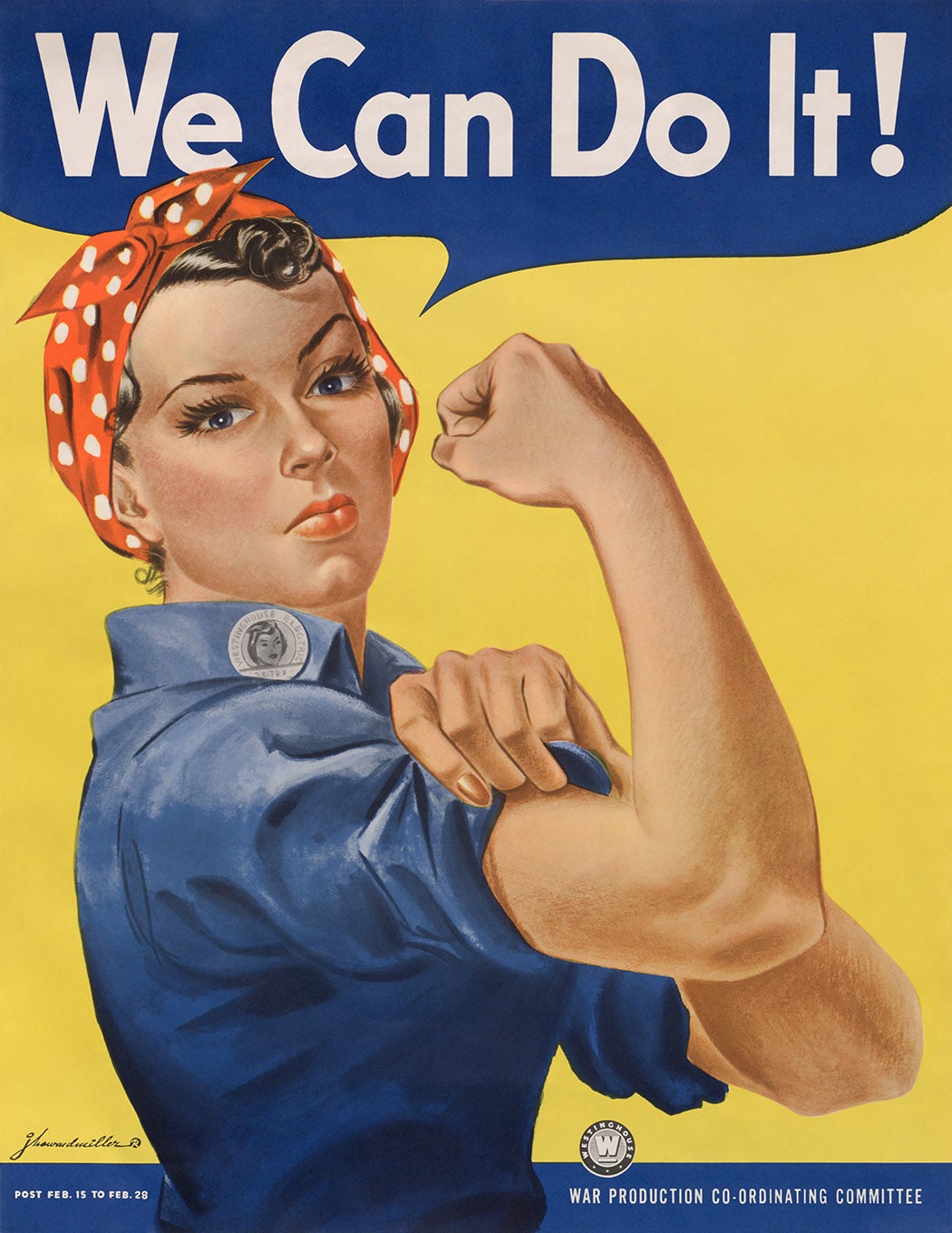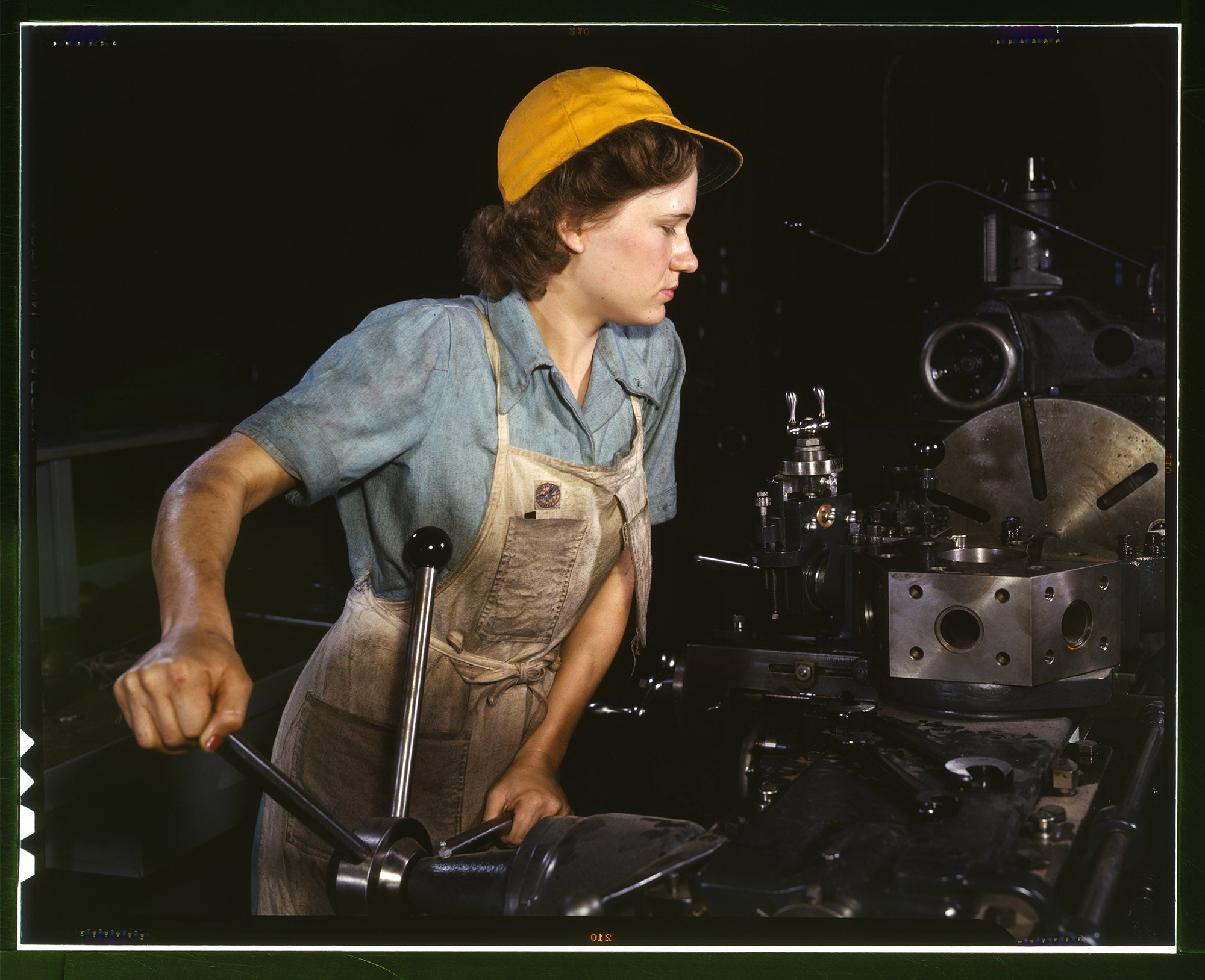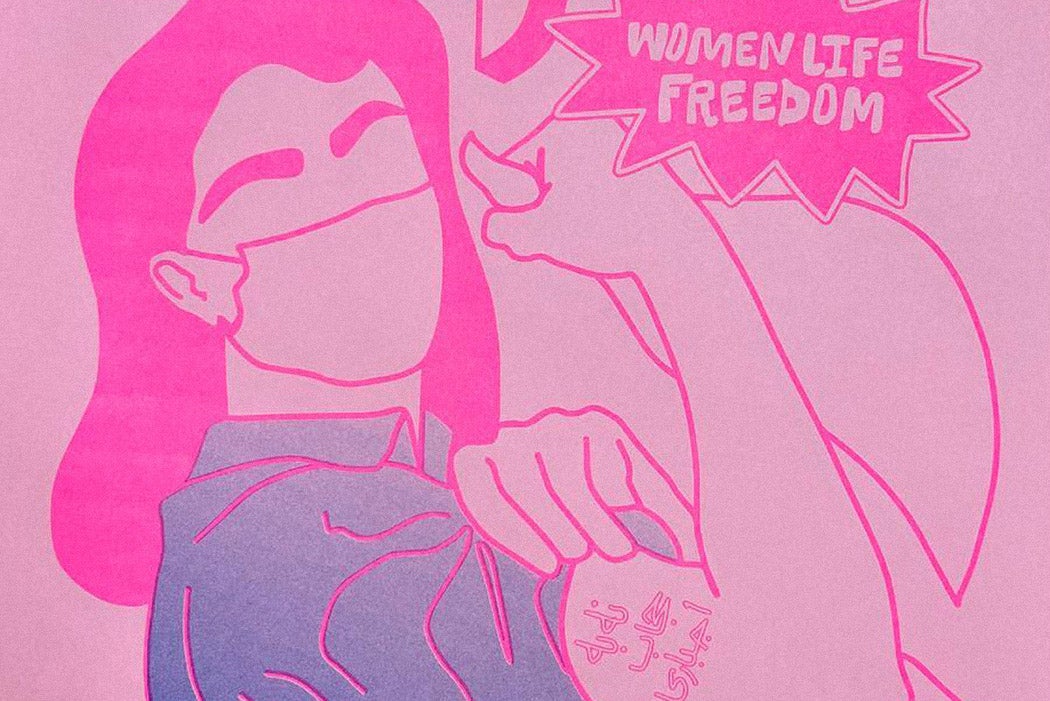After Mahsa Amini was arrested in Tehran for wearing her hijab “improperly” in September 2022, she was reportedly viciously beaten and died in detention. Angry protests soon erupted in Iran and around the world. In support of them, Ghazal Foroutan, an Iranian graphic artist who teaches at Augusta University in Georgia, created an image inspired by the figure we know as “Rosie the Riveter,” and posted it on Instagram, allowing viewers to share the file for free.
Foroutan’s “Rosie” is an Iranian woman demanding her freedom: she waves her headscarf in her hand; it’s white, an emblem of peace. On her arm she bears a tattoo: “No to compulsory hijab.”
Weekly Newsletter
The historical ironies inherent in Foroutan’s use of this particular image are many, though most viewers will fail to detect them, given that the true history of the poster declaring “We Can Do It” has been replaced by a myth in the 80-plus years since it first appeared in 1943.
The fantasy history, to give a representative example from history.com, asserts that “Rosie the Riveter was the star of a campaign aimed at recruiting female workers for defense industries during World War II, and she became perhaps the most iconic image of working women.” This assertion undergirds Rosie’s status as feminist icon, celebrated everywhere from mugs and t-shirts to Beyoncé’s Instagram and children’s picture books.

In fact, as rhetoricians James J. Kimble and Lester C. Olson have demonstrated, “We Can Do It” was produced by artist J. Howard Miller as part of a work-incentive campaign for the Westinghouse Electric and Manufacturing Company. One of many genres of propaganda produced during WWII, work-incentive images were designed to promote wartime productivity and ease tensions between labor and management, averting potential strikes.
As JSTOR Daily has previously pointed out, Miller’s image was not a recruitment poster, and the figure it depicted was not named “Rosie the Riveter.” She had no name at all. The image would likely have been identified only by its slogan: “We Can Do It.” Instead, the phrase “Rosie the Riveter” was the title of a 1943 song by Redd Evans and John Jacob Loeb as well as that of a 1943 Norman Rockwell cover illustration for the Saturday Evening Post.
Crucially, given the mistaken impression that “We Can Do It” was an icon of women’s work during the war, the image’s posting instructions direct that it be displayed in Westinghouse factories for just two weeks in February 1943, making it highly unlikely that the image circulated publicly at all. Far from recruiting women into the workforce, the only women who would have seen “We Can Do It” in the 1940s were those already employed by Westinghouse. Moreover, the poster’s work-incentive message was a far cry from the feminist ethos attributed to the image today.
So, how did an obscure corporate propaganda poster become a symbol of women’s rights and work, one potent enough to be repurposed in transnational women’s activism decades after its creation?
Rosie’s is a story of archives.
From Miller and Westinghouse, “We Can Do It” made its way into the relatively newly constituted U.S. National Archives. Established by Congress in 1934, the National Archives was invested in recording and preserving artifacts from WWII, among other eras, as one of the first momentous periods it chronicled in real time. Once “We Can Do It” entered its holdings, it remained out of the public eye until the early 1980s, when an upstart feminist press expanded its reach among the broader public.
Helaine Victoria Press (HVP) was co-founded in 1973 by Jocelyn Helaine Cohen and Nancy Victoria Poore, feminist activists in California. The press moved to rural Indiana in 1976, where Cohen and Poore printed postcards and other items on a 75-year-old letterpress printing machine. HVP’s “postcards from women’s history” aimed to depict a broader swath of women’s historical activities and contributions than was typically rendered in popular culture. HVP produced and published hundreds of postcards of historical women active in literature, art, politics, education, and a wide variety of occupations in the U.S. and around the world. The cards primarily featured women known to historians but absent from public memory and included brief biographical details on the back. Yet some also featured images of nameless women, like she who would later become Rosie.
The National Archives first circulated a “We Can Do It” postcard in the late 1970s, with no mention of “Rosie the Riveter.” What the card said on its flip side was, simply, “Posters like this are only one of the many types of government records preserved in the National Archives.” Nevertheless, when they included the National Archives card in their 1982 catalogue, Helaine Victoria labeled it “Photo of WWII ‘Rosie’ poster,” forging a direct link between the image and the phrase for the first time.
In 1985, Helaine Victoria began publishing and selling their own version of the card, and “We Can Do It” became “Rosie the Riveter” as we know her today. The new card articulated the familiar myth, explaining that, during World War II, “New popular images in propaganda, like ‘Rosie the Riveter’ were used to recruit women to fill war-time defense jobs which suffered from the ‘man’ power shortage caused by the war.” While the press initially catalogued the card under “Labor,” over time it was moved to a series on feminism and women’s rights called “Beyond the Vote.”
Helaine Victoria Press closed in 1990, but “Rosie the Riveter” lived on, continuing to circulate in part due to its status in the public domain. Unlike Rockwell’s copyrighted Rosie, the image created by Miller and repurposed by Helaine Victoria could be reproduced and adapted free of charge in perpetuity.
Given all this, what do we make of Rosie’s contemporary role as one of the most famous images of women’s work in World War II? “We Can Do It” has been celebrated as a symbol not only that women could do “men’s work” and do it well, but also of public support for that work. Yet historical evidence suggests that women’s industrial work was tolerated as a temporary emergency measure, with women expected to return home and surrender their jobs to returning veterans.

Indeed, actual WWII recruitment posters glamorized war work by featuring attractive young white women whose femininity was unmarred by their unconventional vocations. Office of War Information (OWI) campaigns aimed to convince middle-class women that it was “worth their while to take a step down and enter the blue-collar world.” Moreover, representations of women’s work in and outside the factory depicted women’s wartime employment as comparable to housework, leaving women’s association with domestic labor uncontested. On the whole, OWI recruitment posters bore far less empowering slogans than the renowned “We Can Do It.” While some posters asserted, “Women in the war: we can’t win without them,” others took a scolding tone, admonishing women to “Do the job he left behind.” Worse, some posters sternly chided housewives: “Longing won’t bring him home sooner… Get a war job!”
Rosie’s emblematic status elides the realities and demographics of women’s wartime work. Certainly, the war brought significant changes to women in the workforce. Before Pearl Harbor, 12.1 million women were employed outside the home; by March 1944, that number had increased by 36 percent, to 16.5 million, according to economist Mary Elizabeth Pidgeon.

But new workers were not the only change to the female workforce: 1.46 million women who were working in December 1941 had changed occupations by March 1944. These women did not need to be recruited into the workforce: they were already there. Many were women of color and working-class women of all races and ethnicities who seized opportunities to advance into better compensated and more interesting jobs. Indeed, war industries drew roughly equal numbers of women from existing jobs as from the home, with the greatest increase of women workers in manufacturing (2.5 million) and clerical work (2 million). Tellingly, the only decrease (of 400,000 workers) was in domestic service. As these numbers suggest, Rosie’s popularity perpetuates a counterfactual image of women war workers as predominantly white and middle-class. (Indeed, while Rockwell’s Rosie was visibly marked as working class, the woman in Miller’s “We Can Do It” is perfectly coiffed, with a full face of makeup and long nails unsuited to manual labor.)
There is no one image that can accurately represent the complexities, contradictions, and diversity of women’s work during World War II—or any other period. But we might do well to ask ourselves why this one image has prevailed as a preferred representation of women’s wartime work.

More broadly, how does the true history of the image popularly known as Rosie the Riveter change our understanding of Rosie’s role as feminist icon? For one thing, it suggests that work became increasingly central to feminist messaging in the last quarter of the twentieth century. There was interest—and pride—in a narrative of (white) women’s transition from the home to the workplace, a progress narrative commonly traced to changes to women’s work in WWII.
Additionally, Rosie’s rise to iconicity occurred in a time of significant changes in feminism itself, as the gains of the 1970s and 80s were undermined by cultural backlash and postfeminist assertions that equality had been achieved. Rosie is an apt icon for post-feminism, which centers women’s individual choices rather than collective action. The image, after all, features an individual woman—not the pairs of women who were actually needed for wartime riveting jobs. The perpetual interest in identifying the “real” Rosie further belies the notion of the icon as an “everywoman.” In a potent mixture, Rosie simultaneously purports to represent any number of faceless women heroes on the home front while also depicting those women in a very specific classed, raced, and heteronormative fashion.
In the end, we should care about the real history of Rosie not because we’re wrong, but because our wrongness reveals other elisions in how we tell the story of WWII, women’s work, and feminism in the twentieth and twenty-first centuries. We should also care because Rosie is a transnational product, as Foroutan’s Rosie indicates. Her Rosie shares more common ground with Helaine Victoria’s reinterpretation of “Rosie” than with Miller’s “We Can Do It.” Foroutan’s interest in the effects of the compulsory hijab on women’s lives and careers echoes Helaine Victoria’s use of Rosie to represent women’s continued struggle for equality in civic life and the workplace.
Foroutan’s artistic choices also echo the 1970s feminist postcard printers. Her Rosie was designed using a Risograph, a machine suited for fast, high-volume printing of brightly colored images, such as flyers, meant to be handed out on the street. Helaine Victoria’s choice of postcards for their feminist art was similarly motivated.
“Women’s history has always been hidden,” explained HVP’s Jocelyn Helaine Cohen. “With a notecard, you stick it in an envelope, and that’s where it stays. Postcards offer more exposure: to the giver, the receiver and who knows how many others in between.” Indeed, the feminist messages distributed via such methods are as urgent today as when Helaine Victoria began printing postcards a half-century ago.
Support JSTOR Daily! Join our new membership program on Patreon today.







